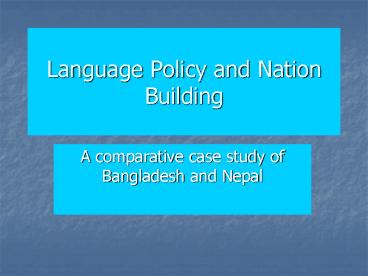Language Policy and Nation Building - PowerPoint PPT Presentation
1 / 11
Title:
Language Policy and Nation Building
Description:
Massive increase in education and literacy s ... of the Hindus, and the Bengali literature was full of Hindu ideas and ideals. ... – PowerPoint PPT presentation
Number of Views:249
Avg rating:3.0/5.0
Title: Language Policy and Nation Building
1
Language Policy and Nation Building
- A comparative case study of Bangladesh and Nepal
2
Language Politics in South Asia
- South Asia as an area of high linguistic
diversity - Shift from dominant languages as those of the
elite (e.g. Persian, English, Urdu) to mass
access and the vernacular - Massive increase in education and literacy s
- Continued inequality in terms of access to
languages of power (e.g. access to resources and
entitlements).
3
Bangladesh Language Movement
- Religion as the key aspect of identity invoked in
post 47 Pakistan - Urdu as language of governance (a minority elite
language in E and W Pakistan) - Tensions emerged in E.Pakistan that can be
explained in terms of a) distribution of power,
b) lack of acceptance of Urdu as the language of
power.
4
- Let me make it clear to you that the State
language of Pakistan is going to be Urdu and no
other language. Anyone who tries to mislead you
is really the enemy of Pakistan. Without one
State language, no nation can remain tied solidly
together and function (Jinnah 1948, in Dhaka).
5
Bangladesh National Identity
Nationalist development in Bangladesh over the
past half century is a fascinating case of
remarkable identity change. The Pakistan movement
in the 1940s, the emergence of Bangladesh within
less than a quarter of a century of the
achievement of Pakistan, and finally the search
for a new identity in post-1971 Bangladesh - all
these facts point at the volatility of
nationalism in Bangladesh (M.H. Kabir 1987).
6
- The ruling authorities of Pakistan felt that
the Bengali language would ultimately impair the
national cohesion of Pakistan. Bengali language
is very different from the languages used in West
Pakistan and it is identical with the language of
West Bengal in India. Thus it was feared that the
encouragement of Bengali might ultimately lead to
the East wing of Pakistan to develop greater
links with West Bengal than with Pakistan. The
upholders of the Islamic ideology further argued
that Bengali was primarily a language of the
Hindus, and the Bengali literature was full of
Hindu ideas and ideals. Hence the condemned
Bengali as un-Islamic. (from Renaissance and
Freedom Movement in Bangladesh by Bhattarcharjee
1973)
7
Changing basis of E.Pakistan, Bengali and
Bangladeshi Identity
- Bengali Language movement from 1948-1952. -
symbolically significant killing February 1952 of
demonstrators protesting for the use of Bangla in
government - Language Martyrs Day (21 Feb) as part of the
symbolism of the new State. 1956 Adoption of
Bangla and Urdu as State languages of Pakistan - Bengali language as on of the key aspects of
Awami League political agenda.
8
Promotion of Nepali Monolingual Nationalism
If the younger generation is taught to use
Nepali as the basic language, then other
languages will gradually disappear, the greater
the national strength and unity will result
(National Education Planning Commission 1956)
9
Nepal - Contested Monolingual Nationalism in a
Multilingual State
- Nepal as a linguistically diverse country (120
languages) - Recognition of languages as a contested area of
State politics - Promotion of Nepali as the language of the State
and of development from the 1950s onward
10
Language Policy and Conflict
- Nepali as the elite language (especially in
education and institutions of government) -
leading to social inequality over access to
resources and entitlements - Post 1990 (democracy) adoption of multilingualism
in the constitution - but resisted in practice by
the high court - Language demonstrations in the 1990s (leading to
acceptance of right to MT education, and change
in broadcasting)
11
Language Policy, Social Exclusion and Conflict
- Limitations of monolingual ideology and practice
(a European model?) - Adoption of monolingualism by dominant groups and
those trying to resist (e.g. irony of both
Bengali language movement and Janajati movement
in Nepal) - Language policy cited in both cases as fuelling
social inequality and conflict - Alternative multilingual approach now being
promoted

